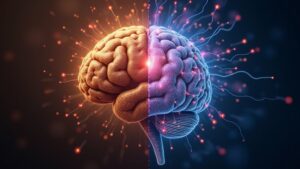Autistic and neurotypical brains show distinct differences in how they function and develop. Research suggests autistic individuals often have increased connectivity in sensory regions but weaker links in areas handling social cues. This can lead to heightened sensitivity to stimuli, intense focus on details, and challenges in interpreting facial expressions or tone. Meanwhile, neurotypical brains typically process information more globally, with stronger social-communication networks.
Comprehension of these variations helps explain why autistic individuals experience the world uniquely and why certain tasks feel effortless while others require extra effort. The next sections investigate these differences in greater depth.
Structural Differences in Brain Anatomy
Although brain structure varies naturally from person to person, research shows consistent differences between autistic and non-autistic brains. Individuals with ASD often have distinct anatomical features, such as increased folding in certain regions during childhood, which later decreases in adolescence. Their brains also tend to be more symmetrical, unlike the typical asymmetry seen in non-autistic individuals. These structural differences might contribute to variations in social and cognitive processing, though the exact connections remain unclear.
Grey matter distribution differs as well, particularly in areas linked to language and sensory functions. Reduced leftward language lateralization is another common trait, potentially explaining higher rates of left-handedness in autistic individuals. Apprehending these unique brain patterns helps normalize the idea that autistic brains aren’t “broken”—just different. Perceiving these distinctions fosters greater empathy and support.
Variations in Sensory Processing and Perception
Sensory processing in autistic individuals often differs markedly from neurotypical experiences, shaping how they interact with the world. These differences can lead to unique challenges and strengths in how they perceive and respond to stimuli.
Autistic individuals may experience extreme reactions to sounds, lights, or textures—either finding them overwhelming or barely noticing them. The brain may struggle to filter sensory information, causing delays or sensory overburden in busy environments. Some autistic people have difficulty sensing body position, affecting coordination and spatial awareness.
These sensory processing differences highlight why autistic individuals might avoid certain situations or seek specific stimuli for comfort. Perception of these variations fosters empathy and better support for their unique needs.
Cognitive Patterns and Information Processing
Why do autistic individuals often notice specifics others overlook? Their brains tend to use a local processing style, concentrating intensely on particular elements rather than the bigger illustration. This heightened sensitivity to sensory stimuli allows them to pick up on subtle patterns or changes neurotypical brains might disregard.
While neurotypical individuals integrate information more fluidly, autistic brains may struggle with combining details from different sources, leading to challenges in tasks requiring broad synthesis. However, this focus also brings cognitive strengths, like exceptional memory, sharp pattern recognition, and remarkable attention to detail. Their attention spans may be less flexible but more concentrated, allowing profound explorations into subjects of interest.
These differences in information processing highlight unique ways autistic brains navigate the world.
Social Communication and Theory of Mind
Social interactions can feel like traversing a maze without a map for many autistic individuals. Neurotypical brains often navigate social cognition effortlessly, but autistic individuals may struggle with perception of social cues, facial expressions, and body language. These differences stem from variations in theory of mind abilities, making it harder to empathize with others’ perspectives or grasp social subtleties.
Autistic individuals may express themselves differently, favoring directness over subtle hints common in neurotypical exchanges.
Challenges in back-and-forth exchanges can arise, as autistic individuals might miss unspoken rules or signals.
Subtle gestures or tones may be overlooked, leading to misunderstandings despite a desire for connection.
While these differences exist, they reflect unique ways of processing the world, not deficits. Awareness of these variations fosters better communication between autistic and neurotypical individuals.
Emotional Regulation and Expression
Emotional regulation and expression work differently in autistic and neurotypical brains, shaping how feelings are processed and shared. The autistic brain often struggles with emotional regulation due to heightened sensory sensitivity and atypical activity in key areas like the amygdala and prefrontal cortex. While the amygdala can overreact to negative stimuli, the prefrontal cortex—responsible for controlling emotions—shows reduced activation, making it harder to manage intense feelings. This can lead to overwhelming emotional responses or difficulty expressing emotions in ways others understand.
Autistic individuals may also experience challenges with emotional reciprocity and empathy, not because they lack care, but because their brains process social cues differently. Cognitive-behavioral therapy can help by teaching strategies to navigate these differences, improving emotional expression and connection.
Neuroplasticity and Developmental Trajectories
Many autistic brains show remarkable flexibility at the outset of life, forming connections in unique ways that help compensate for processing differences. This initial neuroplasticity allows for alternative brain development pathways, supporting adaptation in cognitive, social, and sensory processing.
However, developmental trajectories diverge as age increases, with autistic brains often showing reduced neuroplasticity later in life.
Key differences include:
- Initial Compensation: Strong connectivity in certain regions helps offset challenges, but can lead to uneven skill development.
- Changing Flexibility: Neuroplasticity declines in adolescence, making adaptation to new social or environmental demands harder.
- Widening Gaps: Differences in brain connectivity contribute to growing disparities in social and communication skills compared to neurotypical peers.
Understanding these patterns helps tailor support across the lifespan, ensuring strategies match each developmental phase.
Conclusion
Merely conceiving exploring autistic versus neurotypical brains through MRI scans is akin to comparing two intricate cities with divergent blueprints. Both operate wonderfully, just with distinct street maps and traffic patterns. Discerning these neurological disparities aids in constructing bridges of comprehension, enabling society to value the abundant diversity of human minds rather than perceiving variations as flaws requiring rectification.


